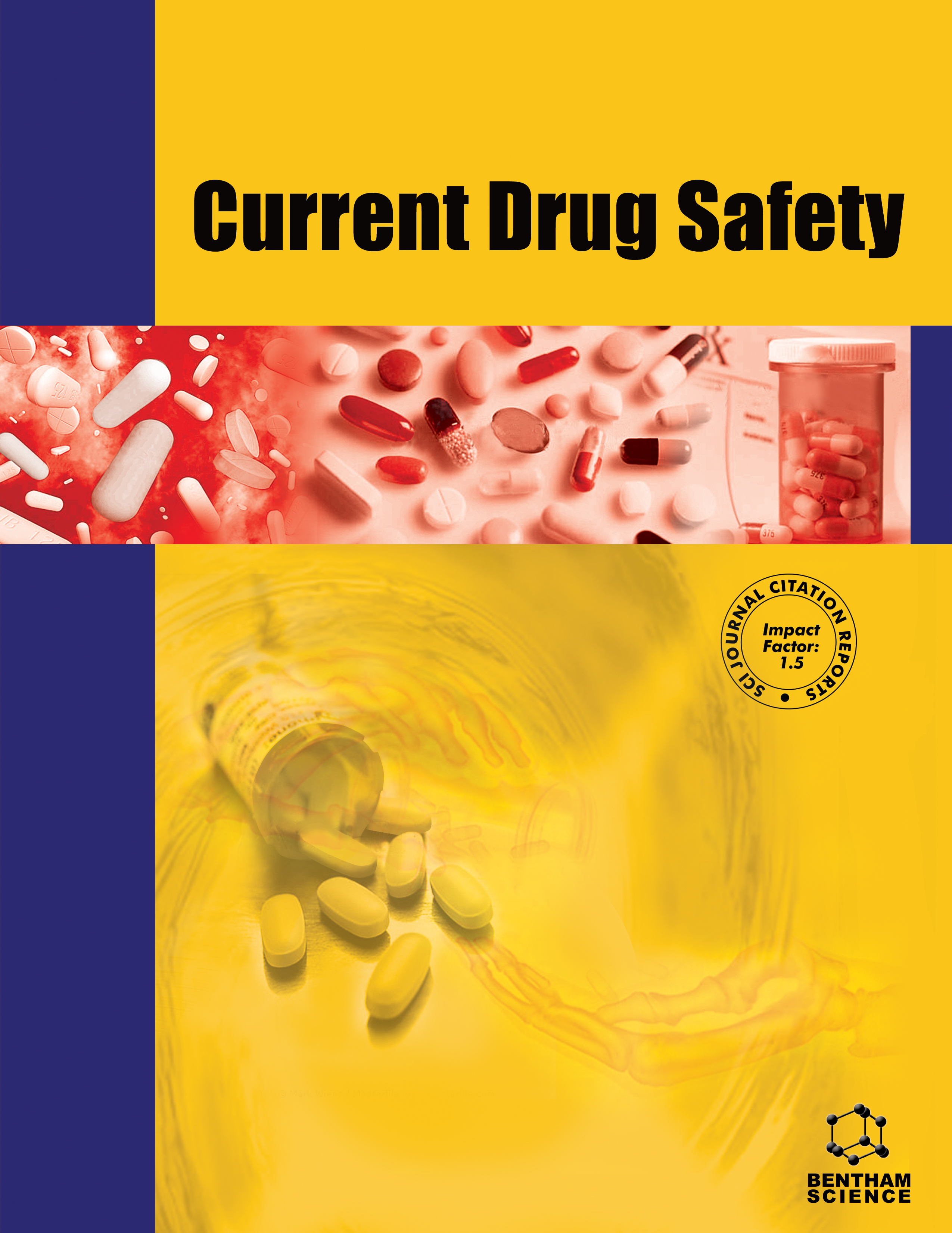- Home
- A-Z Publications
- Current Drug Safety
- Previous Issues
- Volume 8, Issue 2, 2013
Current Drug Safety - Volume 8, Issue 2, 2013
Volume 8, Issue 2, 2013
-
-
Carcinogenicity and Chronic Rodent Toxicity of the Selective Progesterone Receptor Modulator Ulipristal Acetate
More LessAuthors: Oliver Pohl, Philip W. Harvey, Sean McKeag, Scott E. Boley and Jean-Pierre GottelandCarcinogenic properties of ulipristal acetate (UPA), a selective progesterone receptor modulator developed for the treatment of benign gynecological conditions such as uterine fibroids, were assessed in a 26-week carcinogenicity study in transgenic TgRasH2 mice and a 104-week study in Sprague Dawley rats. Dose levels used in the mouse study were 15, 45, or 130 mg/kg/day and for the ratstudy the doses used w Read More
-
-
-
Pattern of Medication Use Among Older Inpatients in Seven Hospitals in Italy: Results from the Criteria to Assess Appropriate Medication Use Among Elderly Complex Patients (CRIME) Project
More LessBackground: Prescribing pharmacological treatment for hospitalized older patients represents a challenge for physicians. In particular, hospitalized older adults present with acute and chronic diseases, which may require multiple treatments and increase their susceptibility to adverse drug reactions. Patterns of drugs use have rarely been investigated in these patients. Objective: to describe patterns of drugs use among hos Read More
-
-
-
The Detection of Adverse Events in Randomized Clinical Trials: Can we Really Say New Medicines are Safe?
More LessAuthors: Izyan A. Wahab, Nicole L. Pratt, Lisa M. Kalisch and Elizabeth E. RougheadBackground: While it is well known that randomized controlled trials (RCTs) are usually designed with sufficient sample size and power to detect the efficacy but not safety of a medicine, the extent to which RCTs quantify safety has not been well ascertained. Purpose: The aim of this study was to assess the safety data available for five commonly prescribed medicines at the time of marketing. Methods: Published RCTs for five medi Read More
-
-
-
A Comparison of Adverse Drug Reactions Between High- and Standard- Dose Trimethoprim-Sulfamethoxazole in the Ambulatory Setting
More LessAuthors: Ann T. Nguyen, Chris A. Gentry and Rona Z. FurrhBackground: High-dose trimethoprim-sulfamethoxazole (TMP-SMX) for the empiric treatment of communityacquired methicillin-resistant Staphylococcus aureus skin and soft tissue infections has been evaluated for efficacy, but characterization of adverse reactions is lacking. Methods: To describe adverse reactions associated with high-dose TMP-SMX therapy, a retrospective medical record review of outpatients receivi Read More
-
-
-
Testosterone Use in Women: How Safe is it?
More LessAuthors: Robert S. Tan and Seng-Hin TeohTreatment of sex hormones deficiencies in men and women is a subject of considerable discussion due in no small measure to safety concerns. In order to appreciate the appropriate balance between potential risk and benefit, it is important to understand the issues at hand. This is particularly true in the case of the use of testosterone in women. To understand the effect of testosterone supplementation in deficient patients, it is Read More
-
-
-
Epidemiology of Major Congenital Malformations with Specific Focus on Teratogens
More LessAuthors: Sonia Chaabane and Anick BerardBackground: Major congenital malformations (MCMs) are a significant cause of infant morbidity and mortality and constitute an important societal and economic burden. Methods: We conducted a literature review to synthesize current evidence on MCMs. Specific objectives were to: 1) summarize internationally reported prevalence of MCMs based on registries and surveillance systems; 2) describe the epidemiology of d Read More
-
-
-
Acute Fulminant Hepatatis in Kidney Transplant Recipient After Repeated Sevoflurane Anesthesia - A Case Report and Literature Review
More LessIntroduction: A liver dysfunction induced by halogenated volatile anaesthetics is considered as a significant diagnostic problem. The aim of our report was to describe the first case of lethal hepatic failure in a female patient undergoing kidney transplantation (KTx) from a living donor after repeated sevoflurane anaesthes. Case Presentation: A 47-year-old hypertensive and diabetic female patient received kidney from her 7 Read More
-
-
-
Cefpodoxime Proxetil-Related Hemolysis and Acute Interstitial Nephritis
More LessAuthors: Hakki Yilmaz, Mukadder Ayse Bilgic, Nuket Bavbek and Ali AkcayObjective: We report a case of acute interstitial nephritis (AIN) and immune hemolytic anemia (IHA) associated with cefpodoxime therapy. Case Summary: A patient with a recent history of cefpodoxime proxetil treatment presented with elevated serum creatinine, oliguria, nausea, vomiting, and dyspnea. Evidence of renal failure, abnormal urinalysis, and renal biopsy with inflammatory infiltrate in the interstitium confirmed a Read More
-
-
-
Severe Hypoglycemia Due to Possible Interaction Between Glibenclamide and Sorafenib in a Patient with Hepatocellular Carcinoma
More LessAuthors: Andreas Holstein, Peter Kovacs and Winfried BeilThere is increasing evidence that tyrosine kinase inhibitors (TKIs) have significant blood glucose lowering effects. A 70-year old Caucasian male with liver cirrhosis Child-Pugh A, advanced hepatocellular carcinoma and diabetes had a stable glycemic control being treated with glibenclamide (3.5 mg twice daily). After the first daily dose of the TKI sorafenib (800 mg) the patient experienced acute nocturnal disorientation and somn Read More
-
Volumes & issues
-
Volume 20 (2025)
-
Volume 19 (2024)
-
Volume 18 (2023)
-
Volume 17 (2022)
-
Volume 16 (2021)
-
Volume 15 (2020)
-
Volume 14 (2019)
-
Volume 13 (2018)
-
Volume 12 (2017)
-
Volume 11 (2016)
-
Volume 10 (2015)
-
Volume 9 (2014)
-
Volume 8 (2013)
-
Volume 7 (2012)
-
Volume 6 (2011)
-
Volume 5 (2010)
-
Volume 4 (2009)
-
Volume 3 (2008)
-
Volume 2 (2007)
-
Volume 1 (2006)
Most Read This Month
Article
content/journals/cds
Journal
10
5
false
en


